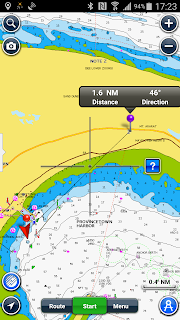Water, water everywhere. But I can't flush!
Back when I owned a house, I would often proudly state "I don't plumb". Every time I would get involved in plumbing, it would be a disaster.
Then I got a boat and as the saying goes "You can't call the plumber out at sea"
Argon has a ShurFlo Fresh water pump. These pumps all work more or less the same: They have an impeller and and some sort of pressure switch that makes the pump only come on when the pressure falls below a certain point.
In our first season, we were anchored overnight in Dutch Harbor, Rhode Island and had a suddenly silent water pump. This is a bit of a thing for us because our head flushes with fresh water! No pump - no flush. Makes for a very unromantic cruise in a hurry.
I took apart the pump and figured out generally how this pressure switch works. I flipped it a few times and put it back together and it was great - for about ten minutes. With a meter, I verified that the little microswitch itself is what failed. It was making very intermittent contact. We called Jamestown Distributors and fortunately they had a replacement pump in stock. The next day, we were back in business with what I figured would be a spare water pump.
What are the odds of that happening again?
Pretty good actually if you fast forward two years. Now, we're living on the boat and in the middle of washing my lunch dishes, the pump died. Having seen this movie before, I took apart the pressure switch, flipped it a few times, put it back together and it was fine - (all together now...) for about ten minutes!This time I called tech support at ShurFlo and explained as calmly as possible that this is the second microswitch that has failed in as many years (the first after just a few months of use). I got a part number for an "upper assembly" (which is on the bottom) for this pump that includes a new switch. I found it in stock at west marine and ordered it overnight. (So now, we also have an upper assembly spare - sans switch). This time, I also found the actual switch online. It's a little Omron microswitch that I've used millions of in my past life as an electronics tech at Universal Instruments. These things are supposed to be good for millions of actuations. I ordered 5 spares from Mouser Electronics.
Why do they fail then?
Below is my rough child's crayon rendering of how this pump is wired in. As you can see, the pump's 12VDC supply is interrupted by this little microswitch in the pressure sensor. This is a spectacularly bad design -but common with these pumps. These switches are not designed to switch motors on and off directly. I can see now why they offer this "upper assembly" maintenance kit. The only thing in that kit that looks like it could fail is the switch. The kit is fifty bucks. The switch is $0.75. No profit in that.Forensic evidence
I did autopsy on the switch by drilling out the fastener that holds it together. Sure enough, there is lots of evidence of arcing on the contacts. It's hard to photograph but here is my best shot:Improving the System
This is why god created relays (the eighth day I think). In your car, when you flip on your lights, the little cheap switch in the dashboard does not switch all that current to the lights. Instead, it energizes a relay coil which draws very little current. The relay's contacts actually switch on your lights. I intend to do the same thing here:Notice the addition of the Automotive Relay. Our little microswitch will now only switch 133mA for that coil. The Relay will switch the 15 to 20 Amps in the motor circuit. I would have much preferred to use a Solid State Relay for this, however DC Output SSRs are sort of rare and I have never seen one that can switch more than 10A. I'd want something with a capacity of at least 30A for this to have some reserve capacity. This relay's contacts are rated for 50A.
 |
| The Automotive Relay wired in and successfully energizing the pump |
ShurFlo suggested we add an Accumulator Tank to our system. Think of this as a water balloon which the pump inflates. The idea is that with the tank's elasticity, the pump will cycle on and off much less often. Okay, that sounds good too so I ordered a small Jabsco 1Liter Accumulator. It won't offer very much elasticity but it will definitely smooth out the pump on/off cycles. Now that the switch is being treated so kindly, I don't expect to have more problems. Anyway, I ordered spare relays and switches just to be sure.
So here is a shot of the whole finished project including the relay and the accumulator. The accumulator alone would have certainly lengthened the lifetime of the switch because it would actuate much less often. But abusing this switch less often is still not such a great solution to me. The addition of the relay treats this switch very gently and well within its design spec.
 |
| The whole system put together with the Automotive Relay and Accumulator |
And......... Flush!





